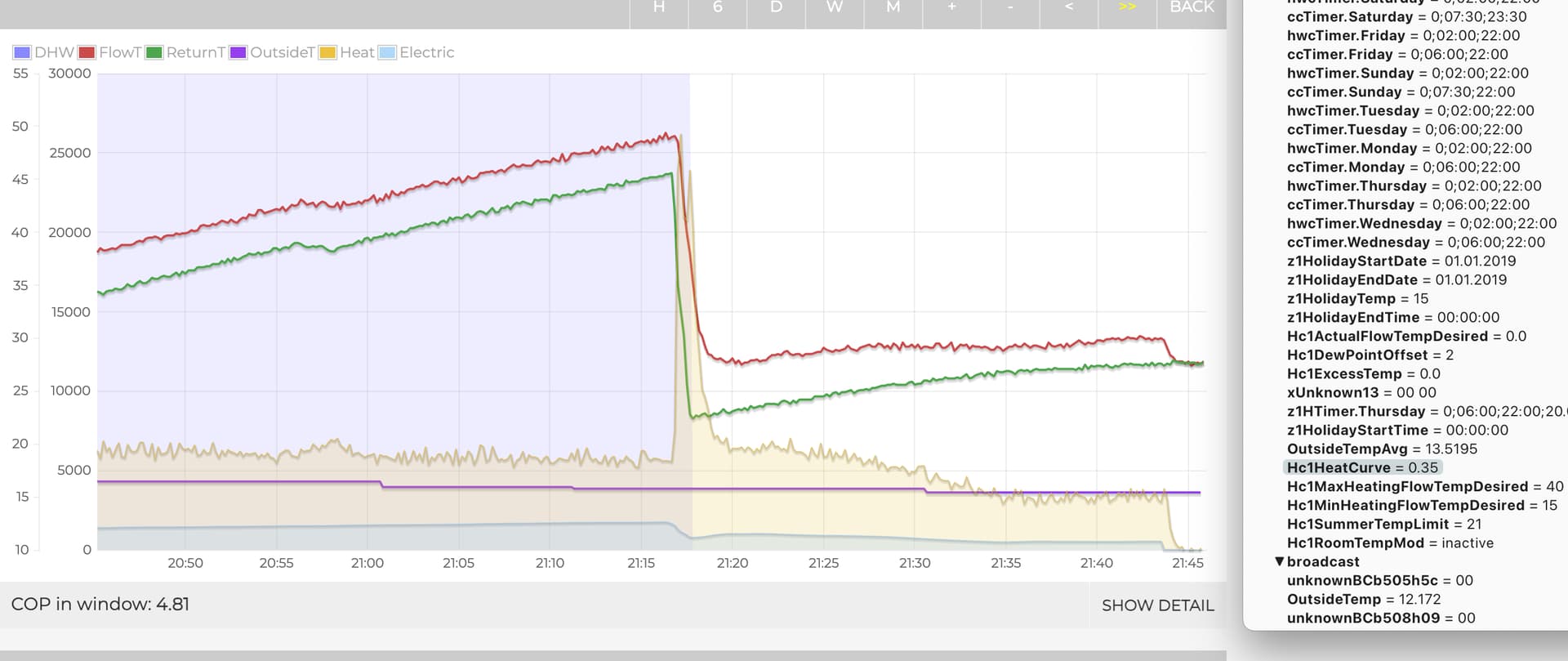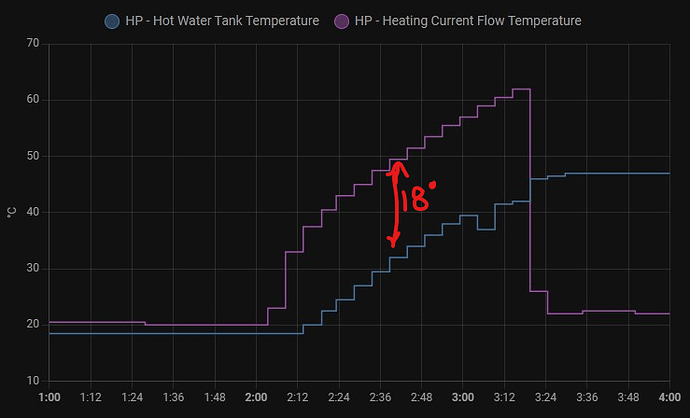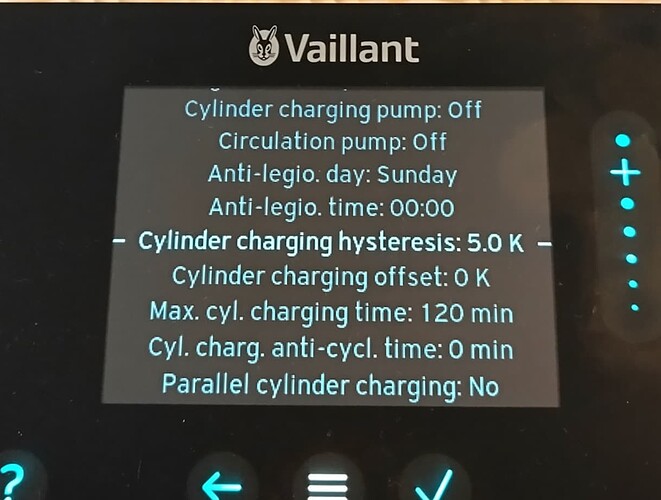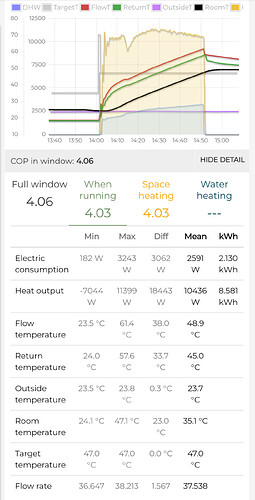We are getting a Arotherm R290 5kW heatpump in two weeks and I wont be able to afford to also install a full emonHP kit but I have read here on the forum that most of the data from the app can be exported to Home Assistant (HA). My understanding is that in general, the monitoring equipment in the Vaillant heatpumps is pretty decent anyway. Can this data be imported to OEM so that my system can be shown on heatpumpmonitor.org? If so, what more than the HA setup do I need to enable this?
I’m pulling data directly into EmonCMS without HA, if that helps:
Note that this can only show electrical consumption and flow temperature, so not heat produced. Good enough to monitor behaviour but not to calculate COP. I’ll try to update that thread with my latest improvements soon…
If you prefer the HA route, there is an emoncms integration that can sync that data for you.
Hi there , I have set my 7kw on a 0.35 curve… The outside temperature according the the weather comp sensor seems to be around 12.17 Deg. C. Indoor target temperature is set at 19C. Would anyone know why the flow temperature is as high as around 30C … Is there some additional override or logic driving up the flow temperature which should have been much lesser if we just looked at the 0.35 curve

This is how it works. There is no logic pushing flow temperature up further, instead it’s almost certainly the fact that demand < min modulation. In this situation, the actual flow temperature will be higher than actual flow temperature for a time until the energy integral rises to 0. Take a look blog post I helped @Zarch write for details of how this control mechanism works.
@dfeist Thank you so much … makes sense !
Hi,
Posting here in this discussion, please let me know if there is a need for a new post or not.
I have HA, several sensors and edbus on my vaillant gas boiler.
I am going to install an Arotherm+ 55 and would like to have it on heatpumpmonitor in order to find the correct COP.
I imagine that I will find the heatpump entities in HA in order to send them to emonscms?
I already sends 2 for testing ( room temp and outside temp)
but I have my doubts about some of them:
- heatpump_elec (Electric use in watts): available?
- heatpump_elec_kwh: I’ve read that this Vaillant meter is MID, so that’s OK.
- Flow rate: available? or is a meter like the Axioma useful?
- FlowT and ReturnT will be available I imagine, as duplicates if Axioma is useful.
Anything else needed ?
and concerning the Heatpump Dashboard in Emonscms apps, is it created automatically as soon as all the necessary feeds are available?
Thanks for your answers already
Ulric
Everything is available, but temperatures would be using Vaillant temp sensors which aren’t always accurate. From my experience power and flow rate are accurate from Vaillant, but not temp sensors. If you want accurate heat meter you’r best using external MID-certified flow meter with temp sensors
Thanks!
… I just read your post about that, will add 2 flow T sensors.
And about the firmware, mine is a 03/2023 build, I checked the firmware and I’m lucky, it’s not 351.06.07 but the 351.09.01
Well, it’s installed, but I can’t see all the parameters from the ebusd MQTT… I’ll make a complete new install of it with the heatpump running to make the auto scan find what I miss
Power is in step of 100W ; no flow value
but this thread Vaillant eBUS hardware adapter (ebusd software) Thread - #99 by Zarch isn’t reassure me
@AndyS I read a post where you were looking into eebus (not ebus) to control the Vaillant AroTherm Plus ASHP. Did you get anywhere with this?
I have an SMA PV Solar array with a Sunny Home Managed and according to Vaillant this can be integrated with an AroTherm to optimise when the ASHP runs based on the weather and output of my solar array.
This requires the sensoNet VR920 for the setup to work. I recently spoke to Vaillant to ask if the newer vr940 supports eebus but they didn’t even seem to know what eebus was and kept confusing ebus with eebus.
For anyone with an SMA Home Manager 2.0 here is the documentation on support for Vaillant ASHP’s.
I would be interested to hear what else you discovered?
I never got very far with eebus other than trying to find some API information. I recall a video on the Vaillant site which showed integration with the Sunny solar system. @dfeist on the site here commented more on EEbus, Vaillant Arotherm Owners Thread - #28 by dfeist. Found EEbus more difficult than ebus to get info for. The vr920 enabled an EEbus section in the old Valliant app which would scan for devices and report them. The current myVAILLANT app has an equivalent, under network settings.
On a related point, myVAILLANT now has an Ambisense devices section instead. The latter, I understand, requires the vr940. In my opinion, the app should only present interfaces to facilities on the systems it is controlling. “Cooling for many days” has finally arrived in a recent aapp update (it was present on the old app!) but is accompanied with “Ventilation Boost”. Surely it is not beyond the Vaillant coders to filter out options that are unsupported on the system!
I have Vaillant ↔ Loxone working via EEBus. It works with old sensoApp and I just checked and it’s still working since vr920 firmware was upgraded to support myVaillant app. I don’t have SMA inverter though, so no idea about this integration… EEBus does work with latest vr920 firmware though. I can’t comment on vr940.
Thanks @dfeist for the reply !
Does anyone else know and have experience with SMA products and the Vaillant VR940?
I tried asking Vaillant’s “professional” technical support team in the U.K. and they didn’t know what eebus was let alone if it was availability on the VR940. It’s always nice to see that companies train their support staff in their own products. ![]()
What are the main feature differences between the vr920 and vr940? Does anyone have any insights/details on this as well as perhaps recommendations?
Thanks again!
Hi,
Maybe take the easy way KISS , received this document from Vaillant Belgium and translated for you :
Vaillant heat pumps are ready for smart grids.pdf (491.8 KB)
Thank you Ulric! I am not sure I have that model but I will check…
Glad to have finished my DIT install of my Arotherm - I think the first one installed in Ireland. Hopefully the distributors of the Vaillant Gas Boilers will soon start supporting the Arotherms too.
Delighted to have added an eBusd to the setup, right from the off
I am also very interested in looking at my data to see how well it might run like a gas boiler - for periods of the day rather than 24hrs. I don’t have a buffer tank, nor am I heating DHW. So the Arotherm is connected straight into the old rads circuit.
I am happy to compromise on efficency for lower running costs
Hi, I have been reading through the great content on this thread and learning a lot. However, I am struggling to understand what is happening in my hot water cycles. I am seeing that there is a gap of about 18K between the flow temperature and the current hot water temperature during the heating cycle (see below). I have the mode set to “ECO” on the VWZ AI Heat Pump Controller and I have the DHW settings set as in the photo below (which I set to try and promote a lower temperature). Unfortunately, I am using data from MyVaillant connect via Home Assistant and I don’t think this gives me the return temperature. I don’t know why the flow temperature is so high; one guess is that the flow rate is too high, so it has to increase the temperature to get to the delta T it expects between flow and return. No idea whether this is what is happening or if it is, what I can do about it.
Any thoughts most welcome ![]()
BTW, when I look back at data from June, it does seem that I was getting significantly lower flow temperatures, but HA aggregates the data to 1-hour granularity, so I don’t see all the detail. I don’t know of anything that has changed since then, but it seems something must have done.
What’s your DHW flow rate (build pump) set at in the heat pump controller?
Can be 50% to 100% or Auto.
And what’s your target hot water temp? I’m assuming 47C ish from the graph?
Looks like your flow peaks about 62.
If the flow rate is low (or you have some sort of restriction) then the DT between flow and return will be wide.
And your target temp will always be below your return.
Imagine another line in the graph between the two existing lines, that would be return.
If you are a tinkerer, have you considered and ebus reader to get at all the values?
This looks ok to me. Here’s yesterdays run of my arotherm, heating to 47°C in eco mode. Room temperature in the graph is actually the tank temperature.18°C offset between flow & tank sounds a tad high, as I am seeing around 14-15 on my setup, but there are lots of variables in there, including sensor inaccuracies, exact DHW tank model & tank sensor location etc. The charging offset in the controller in your screenshot is ignored by the heatpump and probably only there for compatibility reasons with gas burners. With a charging hysteresis of only 5K you’re looking at a relatively bad DHW performance, a higher hysteresis will yield better COP as mentioned elsewhere on this forum - I’m using 20 K.
As @Zarch mentioned, look at your flow rate and a +1 from me to the ebus reader on the Vaillant.
It’s possible that your tank coil isn’t large enough. At any moment, tank heat Q = m.cp.dt of heating fluid = M.Cp.DT of tank contents (plus tank) = U.A.LMTD over the coil. Even with loads of available heat and a cold tank, it won’t warm quickly with a small coil - the heating fluid just goes on heating (via the heat pump) until all three parts of the above equation are satisfied (or you hit cylstat setpoint).
Problem is, a DHW tank is not at steady state - 1) physical properties of heating fluid and tank contents are varying with time as the tank heats, 2) the heating fluid (from and to the Outdoor Unit) is also heating with time, changing the deltaT across the coil wall, 3) the outside film coefficient changes with time as the convection pattern develops in the tank, so U (the OHTC) also varies with time, and 4) thermal layering can occur in the tank so it’s not all at the same temperature, and the location of your temperature instrument may not give you a representative reading.
If you manage to solve everything above, just post us your spreadsheet!
Sarah


